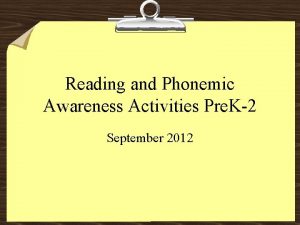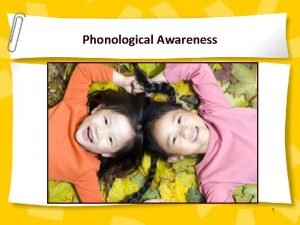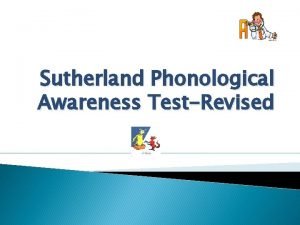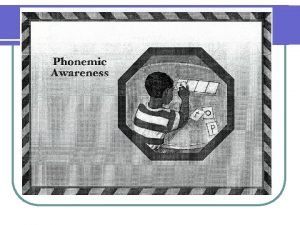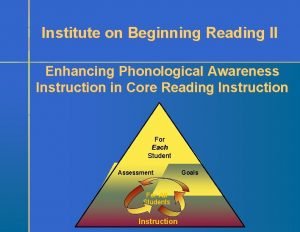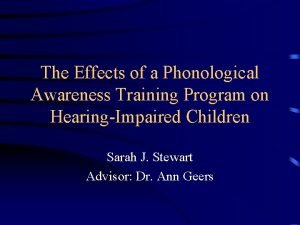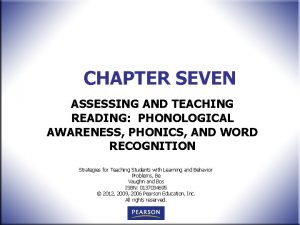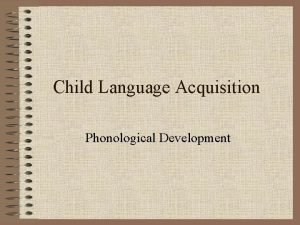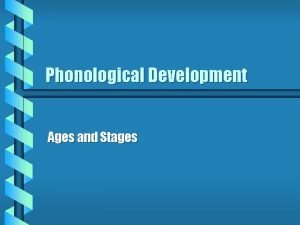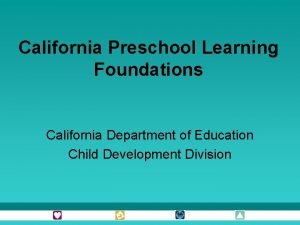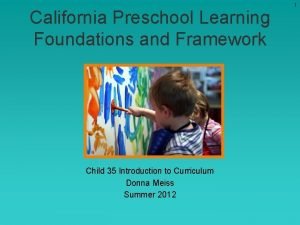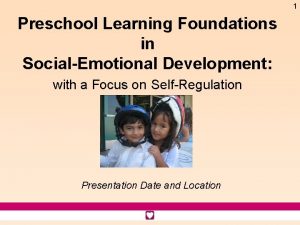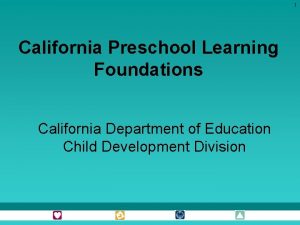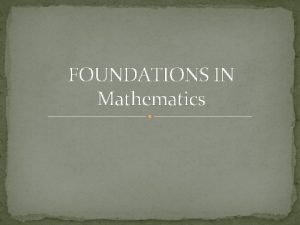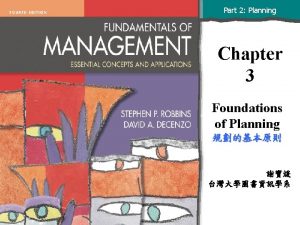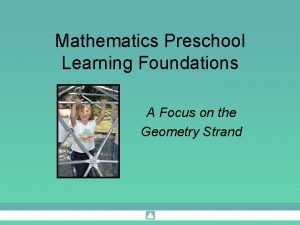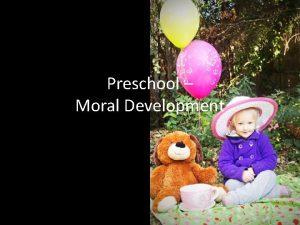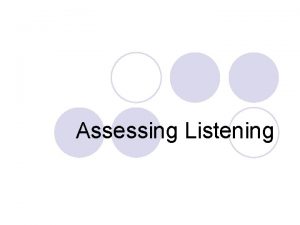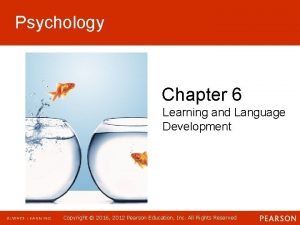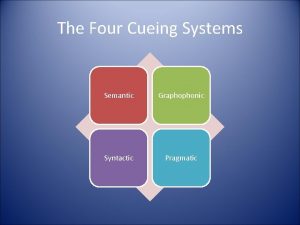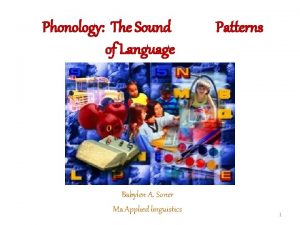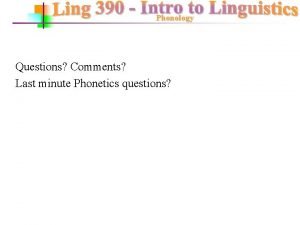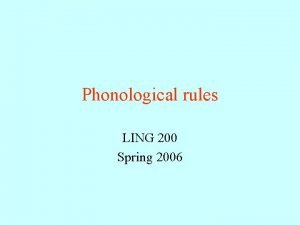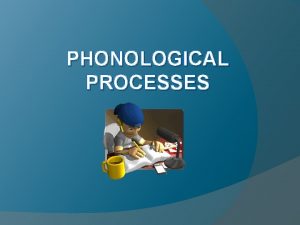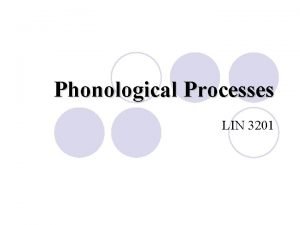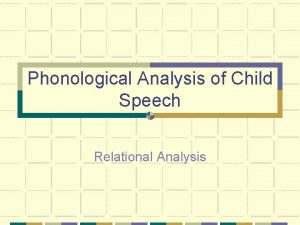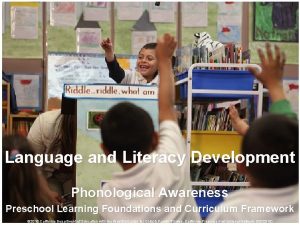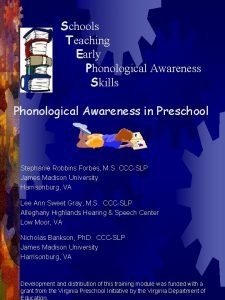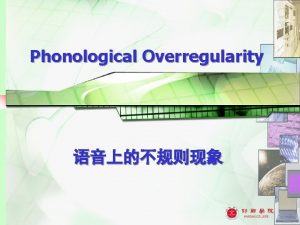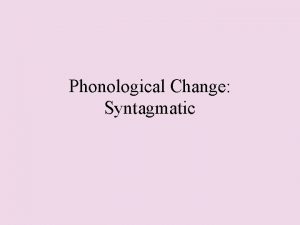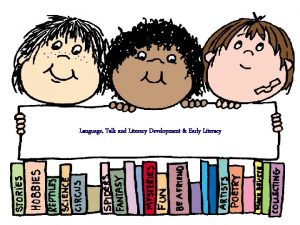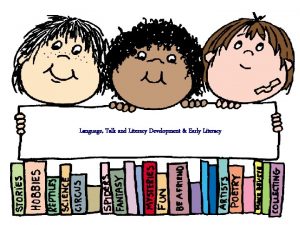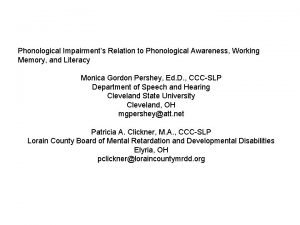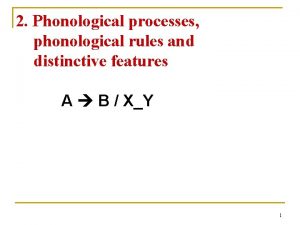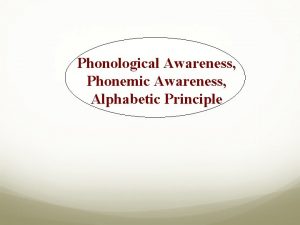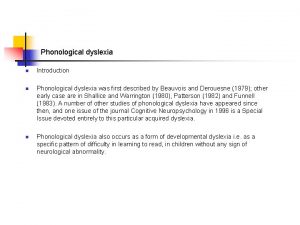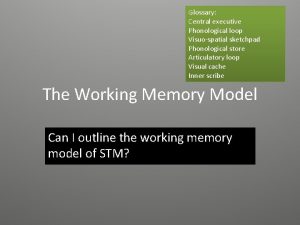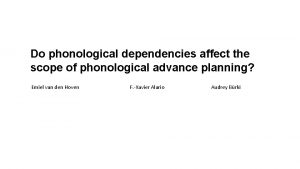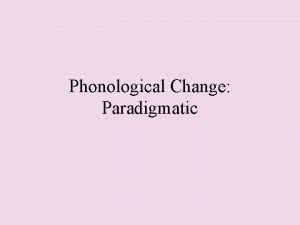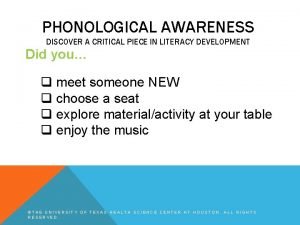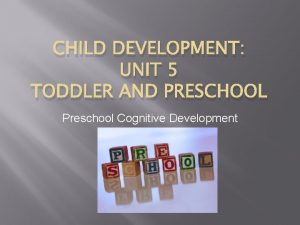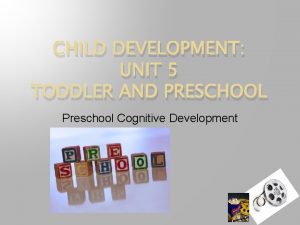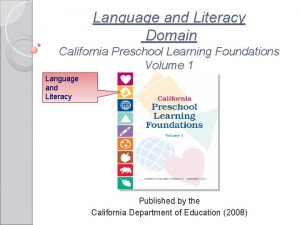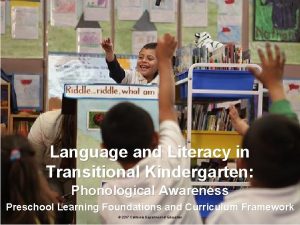Language and Literacy Development Phonological Awareness Preschool Learning





































- Slides: 37

Language and Literacy Development Phonological Awareness Preschool Learning Foundations and Curriculum Framework, Volume 1 © 2020 California Department of Education 1

Objectives: • Explore key concepts from the California Preschool Learning Foundations, Volume 1 and the California Preschool Curriculum Framework, Volume 1—Language and Literacy domain, Phonological Awareness substrand. • Observe, read, and discuss the developmental continuum for vocabulary that will guide instruction and learning in preschool. • Practice using the Preschool Learning Foundations and Preschool Curriculum Framework to intentionally plan developmentally appropriate, cultural, and inclusive strategies that promote the development of skills, knowledge, and behaviors related to language and literacy development. © 2020 California Department of Education 2

What Is Phonological Awareness? “‘Phonological awareness’ is generally defined as an individual’s sensitivity to the sound (or phonological) structure of spoken language. It is an oral language skill that does not involve print” (PLF, Vol. 1, p. 52). © 2020 California Department of Education 3

California’s Early Learning and Development System Start Here 4

Two California Department of Education Resources © 2020 California Department of Education 5

At 48 and 60 months With appropriate support Preschool Learning Foundations After 1 st or 2 nd year of preschool High-quality program © 2020 California Department of Education 6 6

Preschool Curriculum Framework • Developmentally appropriate • Reflective and intentional • Individually and culturally meaningful • Inclusive © 2020 California Department of Education 7

Curriculum Framework • Guiding principles • Environment and materials • Vignettes – Planning learning opportunities – Teachable moments • Interactions and strategies • Engaging families © 2020 California Department of Education 8

Domain: Language and Literacy Domain Organization Strand: Reading Substrands: Concepts about Print Phonological Awareness Alphabetic and Word/Print Recognition Literacy Comprehension Interest and Analysis of Response Age-Appropriate Text Foc us Tod for ay © 2020 California Department of Education 9

Domains and Foundations Work Together LLD substrands: • Concepts about Print • Phonological Awareness • Alphabetic and Word/Print Recognition • Comprehension and Analysis of Age. Appropriate Text • Literacy Interest and Response ELD substrands: • Appreciation and enjoyment of reading and literature • Increasing understanding of book reading • Understanding of print conventions • Awareness that print carries meaning • Progress in knowledge of the alphabet in English • Phonological awareness © 2020 California Department of Education 10

English-Language Development © 2020 California Department of Education 11

Phonological Units and Types of Manipulation Addressed in the ELD and LLD Domains © 2020 California Department of Education 12

Understanding Phonological Awareness • Use Handout: Understanding Phonological Awareness. • In breakout rooms: – Complete the handout with your group. – check answers with one another. © 2020 California Department of Education 13

Phonological Awareness and Reading Success Phonological awareness is a key predictor of reading success. It supports the following skills: • Understanding the alphabetic principle • Decoding printed words • Spelling • Reading comprehension (PLF, Vol. 1, p. 81) © 2020 California Department of Education 14

Focused Video Viewing © 2020 California Department of Education 15

Video Reflection • Consider the following questions: – What did you notice in the video that you have also seen in your classroom? – What did you notice in the video about the developmental progression of phonological awareness? • Share your thoughts. © 2020 California Department of Education 16

Bibliographic Notes Reflection © 2020 California Department of Education 17

Phonological Awareness Substrand 2. 1 At around 48 months of age At around 60 months of age 2. 1 Orally blend and delete words and syllables without the support of pictures or objects: • Orally blend words • Orally blend syllables • Orally take apart words • Orally take apart syllables © 2020 California Department of Education 18

Engagement and Experiences Matter Hands up High Hands on Head © 2020 California Department of Education 19

Universal Design for Learning Multiple means of: • Expression • Representation • Engagement © 2020 California Department of Education 20

Special Considerations for Adaptations “Some children may need assistance in holding a book or turning the pages, either through assistive technology or through the help of an adult or a peer” (PLF, Vol. 1, p. 64). © 2020 California Department of Education 21

Phonological Awareness Substrand 2. 2 At around 48 months of age At around 60 months of age 2. 2 Orally blend the onsets, rimes, and phonemes of words and orally delete the onsets of words, with the support of pictures or objects: • Blend onsets and rimes • Delete onsets • Blend individual phonemes © 2020 California Department of Education 22

DRDP Measure LLD 8: Phonological Awareness © 2020 California Department of Education 23

English-Language Development Domain 6. 0 Children demonstrate phonological awareness • Focus: Rhyming • Focus: Onset (initial sound) • Focus: Sound differences in the home language and English • Read pages 131 -133 of the Preschool Learning Foundations (Volume 1). • Identify key differences. • Be prepared to share. © 2020 California Department of Education 24

Dual Language Learners The development of phonological awareness may differ for children who have a home language other than English. This development is influenced by several factors: • The similarity of the home language to English • The amount of exposure to English • The extent of language and literacy development in the home language • The intensity of English language preschool experiences (PCF, Vol. 1, p. 215) © 2020 California Department of Education 25

Phonological Awareness Across Languages Research supports that “phonological awareness skills are related across languages for bilinguals and appear to transfer between languages” (California’s Best Practices for Young Dual Language Learners: Research Overview Papers [CDE], p. 67). © 2020 California Department of Education 26

ELD Guiding Principle “Recognize existing language and literacy strengths in the home language” (PCF, Vol. 1, p. 180) © 2020 California Department of Education 27

Exploring Strategies • Find Handout: Interactions and Strategies Toolkit. • Focus on the LLD language game strategies that focus on blending sounds, segmenting sounds, and deletion. – Read the LLD “What it could look like: ” column for these strategies. • Look for a similar ELD strategies. – Read the ELD “What it could look like: ” column for these strategies. • Consider what you have noticed. © 2020 California Department of Education 28

LLD Guiding Principle “Children learn best from experiences that are interesting, useful, and fun” (PCF, Vol. 1, p. 101). © 2020 California Department of Education 29

Language Games © 2020 California Department of Education 30

Building Connections “Connect school and home” (PCF, Vol. 1, p. 101). © 2020 California Department of Education 31

What Can You Learn From Families to Support Phonological Awareness? Be a learner first and a teacher second. “Asking about family literacy practices and goals is a useful first step in building on family involvement” (Family Partnerships and Culture [CDE], p. 84). © 2020 California Department of Education 32

Embedding Phonological Awareness “Children learn everywhere” (PCF, Vol. 1, p. 100) © 2020 California Department of Education 33 33

Phonological Awareness Throughout the Day • Locate Handout 12: Daily Routine. • Revisit pages 137 -139 of the Preschool Curriculum Framework (Volume 1). • Fill in the handout with ideas for your daily routine from the pages you read, games you played, and discussion with the group. © 2020 California Department of Education 34

Conversations and Interactions “The most beautiful room is only as good as the interaction that takes place inside it” (PCF, Vol. 1, p. 103). © 2020 California Department of Education 35

Brain Bookmark • Think about final “take-away” ideas from today’s session. • How will you take these ideas back to your learning environment? © 2020 California Department of Education 36

! g n i m o c r o f u o y k n a Th © 2020 California Department of Education 37
 Phoneme identity activities
Phoneme identity activities Phonemic awareness continuum
Phonemic awareness continuum Sutherland phonological awareness test
Sutherland phonological awareness test Phonological continuum
Phonological continuum Phonological awareness skills from easiest to hardest
Phonological awareness skills from easiest to hardest Phonological awareness training program
Phonological awareness training program Phonological awareness
Phonological awareness Consonant correspondences
Consonant correspondences Phonological development in child language acquisition
Phonological development in child language acquisition Phonological development stages
Phonological development stages Cvs privacy awareness training answers
Cvs privacy awareness training answers Multi-cultural literacy
Multi-cultural literacy What is mil subject
What is mil subject What is people media?
What is people media? Cyber literacy and digital literacy
Cyber literacy and digital literacy California preschool learning foundations
California preschool learning foundations California preschool learning foundations volume 1
California preschool learning foundations volume 1 Preschool learning foundations volume 3
Preschool learning foundations volume 3 Preschool learning foundations social emotional
Preschool learning foundations social emotional California preschool learning foundations
California preschool learning foundations Preschool learning foundations math
Preschool learning foundations math Preschool learning foundations
Preschool learning foundations Preschool learning foundations math
Preschool learning foundations math Preschool moral development
Preschool moral development The importance of listening in lang
The importance of listening in lang Chapter 6 learning and language development
Chapter 6 learning and language development Chapter 6 learning and language development
Chapter 6 learning and language development Cuadro comparativo e-learning b-learning m-learning
Cuadro comparativo e-learning b-learning m-learning What is phonological ambiguity
What is phonological ambiguity Syntactic and semantic cues
Syntactic and semantic cues Phonological loop
Phonological loop Phonological loop
Phonological loop Aspiration in phonetics
Aspiration in phonetics Phonology
Phonology Ejective
Ejective Linking vowel to vowel examples
Linking vowel to vowel examples Phonological processes
Phonological processes Phonological process analysis
Phonological process analysis
